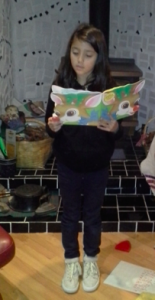
Just say no to flat, expressionless, boring reading. Say yes to smooth, correctly phrased, lilting lyrical reading!
Where do you start?
Read to your tummy. No kidding! Next comes lap reading, then keep reading with your child long after that. This is the first step toward building fluency. By modeling your love of reading, children hear the lilt in your voice, see your expression and experience the joy of language.
I always encourage family reading time, as well as bedtime reading; reading together is the perfect way to enhance fluency.
Following along with online stories is also helpful to see the pictures and hear the words at the same time. Many classic childrens’ stories on the internet are really enjoyable. Using audio books during car trips can be inspiring for your kiddos. Nothing beats hearing great readers sharing stories.
What exactly is fluency and how do we encourage it? Its very definition keeps changing. For example, researchers at one time thought fluency meant a child had no word identification problems. Others stated fluency meant bridging word recognition and comprehension.
Since the definition of fluency continually evolves, form your own opinion. What do you think it means?
In a mechanical aspect, fluency means automaticity, immediately knowing the words and getting meaning from print. First, a budding reader is automatic, then becomes fluent. Developing readers enhance their fluency through lots of practice and repeated readings, reading the same paragraph or page several times to pick up the pace.
Fluency also means reading orally with appropriate speed, accuracy and feeling. We encourage kids to read in phrases, smoothly, with a lot of expression.
A little more to think about:
- Silent reading must be fluent, as well!
- Fluency changes with familiarity of text. New text slows kids down.
- Fluency affects comprehension. More fluent readers know what they read.
- Reading word by word and ‘regressing‘ (back skipping) loses meaning.
- Fluency “testing” is very stressful for children.
Here are ideas for your teaching toolkit for youngest readers:
1. Read together, out loud.
2. Let your child self select the book, at least part of the time.
3. I encourage you to teach the classics.
4. Focus on books featuring rhyme, rhythm and predictable patterns.
5. Practice reading in phrases. Model it.
6. Use a metronome, or tap out phrases (beats) with a pencil.
7. If your child is reading word by word, use easier reading material.
For the easiest way to determine a working reading level, use the ‘five finger technique‘. Ask your child to put down one finger on the page each time a word is unknown. If the book is too hard, five fingers are down right away. This would be at the frustration level.
In order to motivate your child and instill the love of reading, it’s really important to use an independent or instructional leveled book. There can’t possibly be any fluency if the book is too hard to begin with.
If your child is older, a developing reader, here are a more ideas:
1. Choral Read- Read out loud together and to each other, taking turns.
2. Make fun videos reading out loud, especially as a family.
3. Read to another family member or friend.
4. Encourage intonation, emotional reading.
5. Solve any problems such as regression (back skipping).
6. Do Repeated Readings of the same passage to pick up the pace.
7. Use Echo Reading. You whisper read as your child is reading.
As the reader matures, practice rate building activities. Good readers start adapting their rate based on the purpose, why they’re reading something. But this takes a while, so be patient, and start with the basics.
Most important secret of all, if your child is still reading word by word and you think you’ve done it all, go back to the beginning, tracking. Watch how many times your child’s eyes stop on a line of print. The more fixations (eye stops), the slower the reading. So increase the span by being aware, lengthening phrases and reading orally, a lot!
I hope this has been a helpful review of this most interesting topic, reading fluency. Be sure to let me know how you are doing. I’d love to hear from you.
Every child can improve or enhance fluency, at any level!
Leaving footprints on your reading hearts,
Rita
Follow me on Twitter and like me on Facebook!

